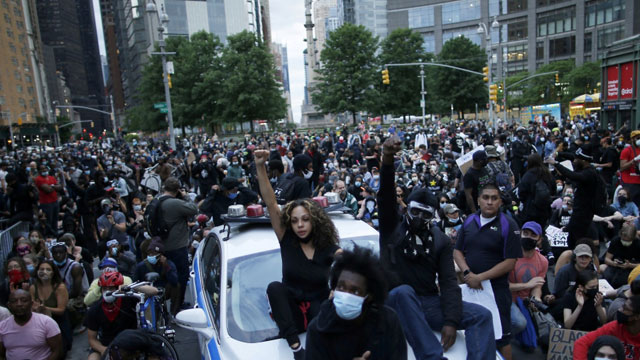"Battlespace" was the word defense secretary Mark Esper used to describe protest sites in the United States. The top US general reinforced that image by appearing in downtown Washington in camouflage during a Monday evening crackdown.
Helicopters that could easily be mistaken for active duty US military ones staged show-of-force maneuvers in Washington above people protesting the killing of George Floyd, an unarmed black man, at the hands of a white police officer in Minneapolis.
As president Donald Trump increasingly turns to militaristic rhetoric at a time of national upheaval, the US military appears to be playing a supporting role - alarming current and former officials who see danger to the US armed forces, one of America's most revered and well funded institutions.
"America is not a battleground. Our fellow citizens are not the enemy," Martin Dempsey, the retired four-star general who served as chairman of the Joint Chiefs of Staff, wrote on Twitter.
A current military official, speaking on condition of anonymity, voiced concern about the lasting damage that would come from using the military as a "political prop."
"Presidents come and go ... the uniform has to be maintained," the official said.
For Trump's critics, the Republican president's reliance on the military in domestic endeavours risks making the armed forces, which are meant to be apolitical, appear aligned with Trump's political agenda. He has previously employed the military to help stem illegal immigration and used defense funding to build his border wall.
But drawing the military into his response to the sometimes violent civil unrest that broke out in Minneapolis last week and spread to dozens of cities, is particularly problematic.
At the core of the discomfort is a single idea: The military was designed to protect the United States from foreign adversaries and uphold a constitution that explicitly protects the rights of citizens to protest peacefully.
Even the head of the National Guard acknowledged that responding to domestic crises makes his troops uneasy. So far, more than 20,000 National Guard members have been called up to assist local law enforcement with protests around the country.
"This mission is an uncomfortable mission. They don't like doing it, but we can do it," said General Joseph Lengyel, chief of the National Guard Bureau.
Unwitting support?
Esper and General Mark Milley, chairman of the Joint Chiefs of Staff, accompanied Trump on Monday as he posed at a church near the White House while holding a Bible after law enforcement officers used teargas and rubber bullets to clear the area of peaceful protesters.
Trump had just delivered a speech condemning "acts of domestic terror" and saying the United States was in the grips of professional anarchists, violent mobs, arsonists, looters, criminals and others.
A senior defense official suggested neither Esper nor Milley knew about the photo-op and had been at the White House to give Trump an update on response efforts.
"As that meeting concluded, the president indicated an interest in viewing the troops that were outside and the secretary and the chairman went with him to do so. That's the extent of what was taking place," the official said, speaking on condition of anonymity.-Reuters





